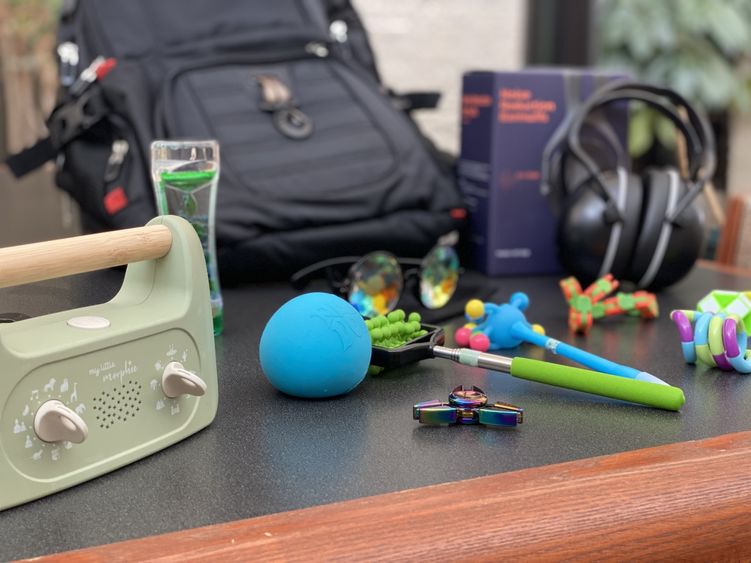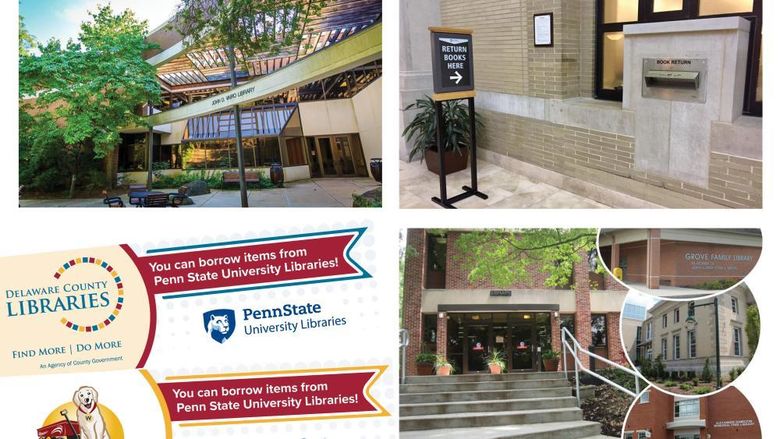
Penn State Berks Thun Library offers a variety of tools to encourage positive sensory experiences in the library's Sensory Room.
UNIVERSITY PARK, Pa. — For students who need a break from the cacophony of campus life, a growing number of sensory spaces at locations across Penn State University Libraries can offer quiet comfort.
The University Libraries, as part of the LibWell initiative, is currently piloting three sensory rooms, located within Penn State Berks’ Thun Library, Penn State Brandywine’s Vairo Library, and in Pattee Library on the University Park campus, to assist students with sensory impairments and neurodiversity.
“The Libraries is committed to advancing the success and well-being of our students, and that means thinking about our spaces, services, resources and programs differently,” said Rebecca Miller Waltz, University Libraries’ associate dean for learning and engagement. “These sensory rooms are a great example of re-envisioning spaces and prioritizing resources in a way that directly supports our students’ needs. We hope that this is just the first step of many that will ultimately lead us toward more inclusive, welcoming and supportive spaces for our community.”
What is a sensory room?
Sensory rooms use specialized equipment, furniture and lighting to generate a controlled sensory-focused environment that calms the nervous system, increases feelings of safety, and lowers stress and anxiety. Also called multi-sensory environments, these spaces offer a form of accommodation that can help meet the needs of a growing population of neurodiverse students, such as those living with autism, attention deficit/hyperactivity disorder, dyslexia and PTSD. While every room is different, the goal is to create a sense of calm and relaxation through gentle sensory cues.
“There is a strong need for therapeutic spaces at colleges that can help students block out harmful sensory distractions and relieve the huge burden of anxiety many students bear,” said Brett Spencer, reference and instruction librarian for Penn State Berks’ Thun Library. “We want to make sensory-safe places that can help students maximize their wellness and learning.”
Why offer sensory rooms?
Current studies show that up to one in 20 students may be affected by sensory processing disorders or deal with particularly serious sensory problems that can interfere with their studies. Around 39% of students with autism graduate from college compared to 52% of the general student body, and sensory issues are a contributing factor to lower graduation rates. Additionally, anxiety and depression has surged among college students, including Penn State students, since the beginning of the COVID-19 pandemic, making it more important than ever to ease their stress burden. Sensory rooms can help reduce these barriers to wellness and offer a sense of belonging for students who often face prejudice and stigma.
“We know from new research and our campus disability coordinator that neurodivergent students are a growing part of our population, and we felt we could improve our spaces for these students,” said Teresa Slobuski, head librarian at Penn State Brandywine’s Vairo Library.
Vairo Library’s Sensory Room, located in a quiet area to the rear of the library, is filled with comfort enhancing furniture like spinning low stools, floor cushions and an Alpha Egg Chair, as well as forest-inspired dimmable lighting, weighted lap blankets, fidget toys and noise-canceling headphones. Relaxation tools, puzzles, coloring supplies and a tabletop Zen Garden round out the offerings designed to restore balance and comfort to neurodiverse visitors.
Slobuski said Vairo Library is actively soliciting feedback from sensory room users to ascertain what additional tools or technology might be useful to add in the future. The library plans to offer at least one new item every month, with plans for more therapeutic furniture in 2024.
At Thun Library’s Sensory Room, windows open the space to the outdoors, creating a sense of calm. The room features an Alpha Egg chair, Buddha Board, yoga supplies, foam rollers, sound mixer, weighted lap blankets and fidget tools. A bubble tower generates soothing white noise and soft lighting, and hologram generators offer visual stimming. Students can reserve the room for up to 90 minutes, and a wellness LibGuide was created to accompany its use.
Spencer said students with sensory issues may find traditional chairs, desks and carrels to be restrictive, but soft, floor-level seating such as bean bags, floor chairs and desks, and fit ball seats offer more comfortable options. Since many neurodivergent learners process sensory information more efficiently when they can fidget or rock on wobble stools or rocking chairs, Thun Library hopes to include more occupational therapist-recommended furniture in the future.
At University Park, students can relax in the Sensory Space, located within the Collaboration Commons at Pattee Library. The room was conceptualized and outfitted entirely by students in the Evanisko Project, a multi-year grant collaboration between University Libraries and the Department of Graphic Design to establish and highlight student work within the Libraries. Pattee Library’s Sensory Space utilizes colored lighting, tactile puzzles, sensory stickers, yoga props, weighted blankets and an Alpha Egg Chair, purposefully chosen to provide a sense of relief using positive sensory experiences.
Who can visit the Libraries’ sensory spaces?
“Anyone who feels overwhelmed by the stressors of academic life is welcome here,” said Slobuski, who added that spaces like the Libraries’ sensory rooms demonstrate the University Libraries’ commitment to every student’s well-being.”
Spencer agrees. “All students are welcome to use the room. Students who need sensory relief are especially encouraged to spend time here. Students who just need a break from the hustle and bustle of campus or a place to destress from an exam are welcome to visit the room. These spaces communicate to all students that they are valued here.”
“With a relatively small budget we were able to make huge improvements to better support our students, many of whom have reported that the Sensory Room is their new favorite location on campus,” Slobuski said. “This is the difference that a supportive space can make for our students.”
Information about sensory rooms at Penn State University Libraries, including inquiries about space accommodations and reservations, is available at participating campus locations:
- Berks Thun Library’s Sensory Room 115, Penn State Berks, contact Brett Spencer at [email protected] or 610-396-6339.
- Vairo Library’s Sensory Room at Penn State Brandywine, contactTeresa Slobuski at [email protected] or 610-892-1380.
- Pattee Library’s Sensory Space W027, Collaboration Commons, at Penn State University Park, contact Hannah Strouse, Evanisko Project coordinator at [email protected] or Common Services at 814-865-5429.
To learn more about the University Libraries Student Wellness Fund, contact Gretchen Little, assistant director of Alumni and Donor Relations, Penn State University Libraries, at [email protected].





